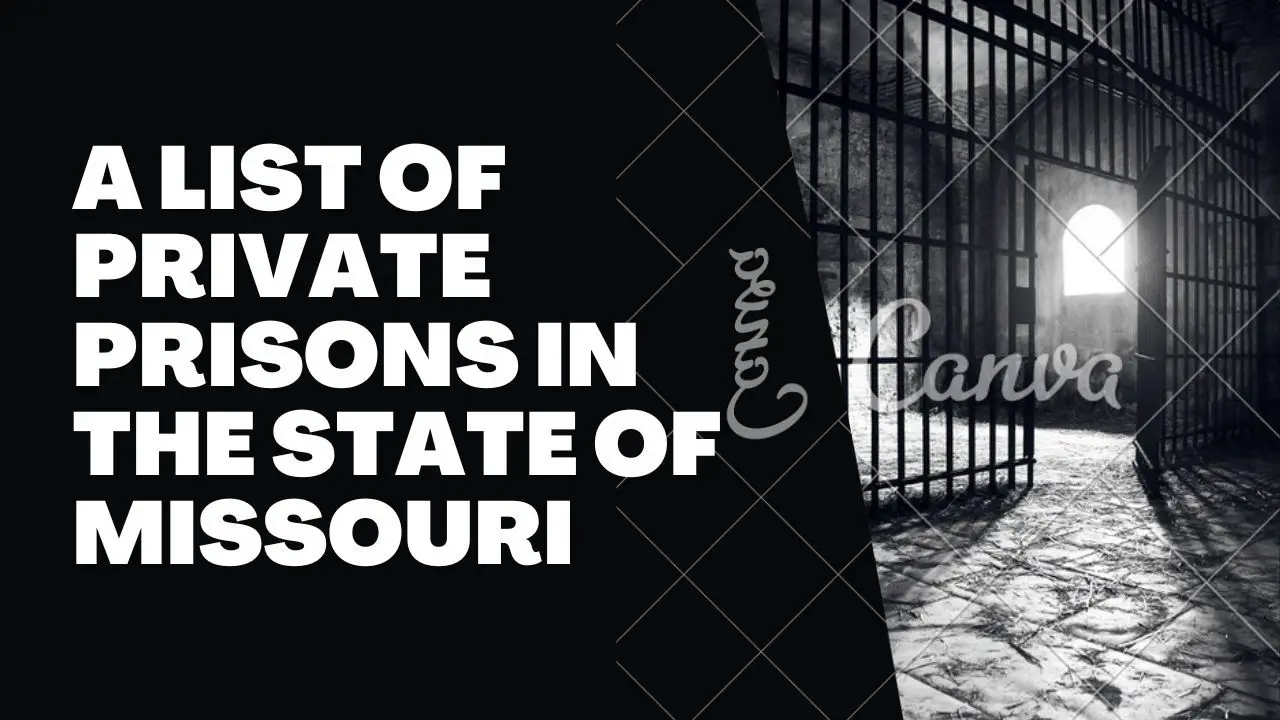A List of Private Prisons in The State of Missouri
This article brings you a list of private prisons in the state of Missouri with all the important details.

Missouri is the 19th state of the US with the highest population. Due to a high population, the crime and incarceration rate in the region is also high. The Missouri Department of Corrections (MDOC) incarcerates 735 people per 100,000 in the state; this incarceration rate is higher than other democracies worldwide.
MDOC has 21 correctional facilities, including 2 community release programs. The Department of Corrections, Missouri, divides the prisons into state, federal, and county jails. This article gives you a list of private prisons in the state of Missouri and other related information.
A List of Private Prisons in the State of Missouri
Missouri has an extensive number of prisons, amounting to 21, yet the state corrections department has no private prisons as of 2023. The previous private prisons in the state include:
- Integrity Correctional Center near Holden, Missouri
- Bridewell Prison, Bethany, Missouri
Previously in 1995, the state sent prisoners to the Newton County Correctional Center in Newton, Texas, as a temporary solution to overcrowding. Moreover, the two private prisons mentioned above were also closed by 2010; the state did not keep offenders from Missouri in these prisons anyway.
Read Full List of Private Prisons in the State of New Hampshire
Missouri 2019 Stats
- Incarceration Rate Missouri per 100,000: 424
- Jails in Missouri: 117
- Jail population: 12,000
- Prisons in Missouri: 22
- Prison population: 26,044
- Prison staff: 11,232
- Missouri prison budget: $778,431,128
- Property crime rate per 100,000: 2,639
- Violent crime rate per 100,000: 495
- Community corrections population under probation: 43,413
- Community corrections population under parole: 21,520
Missouri Prisons Downsizing
The state government started downsizing prisons due to state criminal code changes. They are replacing incarceration with probation in many cases, reducing the prisoner population.
Budget director Dan Haug said, ‘‘What they are doing is they are consolidating space within various prisons around the state, closing certain housing units and those types of things.”
DOC spokesperson Karen Pojmann mentioned, "Closing housing units reduces staffing needs and enables the department to more effectively and efficiently staff facilities, boost safety and reduce mandatory overtime. We're hoping these changes also can reduce staff stress and improve retention."
The state is removing 1,756 beds for prisoners, and the prisons will no longer need to fill vacant staffing spots, allowing the state to save $6.5 million. The Department of Corrections plans to use $3 million to add more radios to other facilities and repair security cameras.
It will reduce over 2,600 beds, which Karen Pojmann addressed as, “If approved, these upgrades will make our worksites safer, support field staff and ensure more efficient use of taxpayer dollars.”
Read Can You Leave Prison For a Wedding?
List of Prisons in Missouri
Algoa Correctional Center (ACC)
The Algoa Correctional Center is one of the largest prisons in Missouri, with a capacity of 1,600, run by 470 MDOC-trained officials. ACC is a medium-level security prison.
Cremer Therapeutic Community Center (CTCC)
Cremer Therapeutic Community Center Fulton, Callaway County, is a medium-level security prison. It primarily acts as a treatment center for male inmates.
Missouri Eastern Correctional Center (MECC)
The Missouri Eastern Correctional Center is at Old Highway, 66 Pacific, Missouri, and was opened in 1981. It is a minimum to medium-level prison with a capacity of over a thousand inmates.
Western Missouri Correctional Center (WMCC)
The Western Missouri Correctional Center WMCC was opened in 1988 in Clinton County with over 1975 housing capacity. It is a medium to maximum-level security prison.
Boonville Correctional Center (BCC)
Boonville Correctional Center is a medium-level prison that opened in 1983. It houses 1316 prisoners from different parts of the country.
Chillicothe Correctional Center (CCC)
Chillicothe Correctional Center at Chillicothe, Livingston County, opened in 2008, has over 1740 female inmates with a yearly budget of $120 million.
It has prisoners requiring all levels of security, including minimum, medium, and maximum level security.
Potosi Correctional Center (PCC)
This prison, located at state highway O mineral point, Missouri, is a maximum-level security prison with a housing capacity of 800 inmates. It is also an execution chamber.
Farmington Correctional Center (FCC)
This correctional facility is located in Farmington, Missouri, and can house over 2600 prisoners. It is a minimum to medium-level security prison.
The Farmington Correctional Center is the second-largest state prison in Missouri.
Northeast Correctional Center (NCC)
The Northeast Correctional Center, or NCC, opened in 1998 and can house around 3000 inmates requiring minimum and medium-level security.
Missouri State Penitentiary (MSP)
The Missouri State Penitentiary in Jefferson City was opened in 1836 and held operations until 2004. It is a medium to maximum-level security prison.
Crossroads Correctional Center (CRCC)
This correctional center in Clinton County was opened in 1997 but closed in 2019. It has room for 1400+ inmates and is a maximum-level security prison.
Eastern Reception, Diagnostic and Correctional Center (ERDCC)
The Eastern Reception, Diagnostic and Correctional Center, commonly known as ARDCC, is the largest prison in MDOC, with a capacity of over 2680.
It has a variety of security levels, including minimum, medium, and maximum-level security, as it acts as an execution chamber for death row prisoners.
Fulton Reception and Diagnostic Center (FRDC)
This prison is also a diagnostic center for prisoners that need mental health diagnosis and help. It is a medium-security prison.
Jefferson City Correctional Center (JCCC)
The Jefferson City Correctional Center, located in Jefferson City, was opened in 2004. It is a maximum-level security prison that can keep 1996 male prisoners.
Kansas City Reentry Center (KCRC)
KCRC is a minimum-level security prison with an inmate capacity of 430 offenders. It was opened in 2015.
Maryville Treatment Center (MTC)
The Maryville treatment center is a treatment facility for male prisoners at Mount Alverno. It opened in 1996 and can keep 561 offenders. Maryville Treatment Center is a minimum-level security prison.
Moberly Correctional Center (MCC)
This correctional center is a prison for 1800 male inmates in Moberly, Missouri. It opened in 1963 and has a minimum and medium-level security prison.
Women’s Eastern Reception, Diagnostic and Correctional Center (WERDCC)
This prison is a minimum, medium, and maximum-security facility for females with a diagnostic center for female inmates with mental issues.
State Vs. County Prison
Missouri has a mix of federal, state, and county prisons to keep prisons with varying offenses in need of a particular security level.
State prisons come under the operation and administration of MDOC directly and house prisoners convicted of their crimes in a state court. However, the correctional programs in Missouri State Prisons have received criticism as most offenders are rearrested within three years of their release.
At the same time, the state’s sheriff’s office operates county jails which are administered by the Missouri Department of Corrections. These prisons typically have prisoners with violent crimes and a small number of minor crime offenders.
Final Words
Missouri does not have a long list of private prisons in the state of Missouri. The state operated two prisons under the state's administration, including the Integrity Correctional Center near Holden and Bridewell Prison, Bethany, Missouri.
Besides these prisons, the state is also downsizing other prisons due to implementing policies such as reduced incarceration and more probation. This has led to massive savings by the state government that can be used in repairs in other facilities, including additional radios and fixing security cameras.
